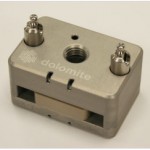Dolomite’s microfluidic chips provide channel networks with geometries of interest to a wide variety of markets. Fabricated to the highest quality standards in glass or fused silica, these chips are particularly suitable for applications where reusability, chemical compatibility, optical transparency and thermal characteristics are important. Dolomite also supplies a range of PDMS Droplet Chips specially designed for biological applications.
 [spoiler title=”Porous Media Chip” style=”fancy” icon=”arrow”]The Porous Media Chip is a glass microfluidic device designed for statistically representative modelling of a complex porous sandstone rock structure. Applications include academic research (earth science and engineering), petrochemical industry, and environmental testing and groundwater analysis.Features and benefits: [spoiler title=”Porous Media Chip” style=”fancy” icon=”arrow”]The Porous Media Chip is a glass microfluidic device designed for statistically representative modelling of a complex porous sandstone rock structure. Applications include academic research (earth science and engineering), petrochemical industry, and environmental testing and groundwater analysis.Features and benefits:
|
 [spoiler title=”Droplet Chips” style=”fancy” icon=”arrow”]Dolomite offers a wide range of Glass Droplet Chips with different junction geometries, channel sizes and surface properties. All Droplet Chips have excellent optical transparency for clear imaging of droplets. Advanced hydrophobic coating treatments enable water-in-oil droplets to be generated as well as oil-in-water droplets formed in the untreated chips.Dolomite is a licensee of Japan Science and Technology Agency (“JST”) under JST’s microdroplet generation technology. This enables our customers to purchase and use our droplet chips for R&D purposes without any restriction from this comprehensive IP family. Contact us for more information about licensing this IP for your custom application or chip design.[/spoiler] [spoiler title=”Droplet Chips” style=”fancy” icon=”arrow”]Dolomite offers a wide range of Glass Droplet Chips with different junction geometries, channel sizes and surface properties. All Droplet Chips have excellent optical transparency for clear imaging of droplets. Advanced hydrophobic coating treatments enable water-in-oil droplets to be generated as well as oil-in-water droplets formed in the untreated chips.Dolomite is a licensee of Japan Science and Technology Agency (“JST”) under JST’s microdroplet generation technology. This enables our customers to purchase and use our droplet chips for R&D purposes without any restriction from this comprehensive IP family. Contact us for more information about licensing this IP for your custom application or chip design.[/spoiler] |
 [spoiler title=”Mixer Chips” style=”fancy” icon=”arrow”]Designed for millisecond mixing of two fluid streams, the Micromixer Chips benefit a wide range of applications including reaction kinetics, sample dilution, rapid crystallisation and nanoparticle synthesis.[/spoiler] [spoiler title=”Mixer Chips” style=”fancy” icon=”arrow”]Designed for millisecond mixing of two fluid streams, the Micromixer Chips benefit a wide range of applications including reaction kinetics, sample dilution, rapid crystallisation and nanoparticle synthesis.[/spoiler] |
 [spoiler title=”T-Junction Chips” style=”fancy” icon=”arrow”]The T-Junction is a basic geometry used in microfluidics for liquid contacting and droplet formation. Dolomite offers this chips in a wide range of formats including thin layer, quartz, platinum coated, hydrophobic and hydrophilic versions.[/spoiler] [spoiler title=”T-Junction Chips” style=”fancy” icon=”arrow”]The T-Junction is a basic geometry used in microfluidics for liquid contacting and droplet formation. Dolomite offers this chips in a wide range of formats including thin layer, quartz, platinum coated, hydrophobic and hydrophilic versions.[/spoiler] |
 [spoiler title=”Reactor Chips” style=”fancy” icon=”arrow”]The Microreactor Chips are compact glass microfluidic devices designed for rapid mixing and reaction of two or three liquid reagent streams.[/spoiler] [spoiler title=”Reactor Chips” style=”fancy” icon=”arrow”]The Microreactor Chips are compact glass microfluidic devices designed for rapid mixing and reaction of two or three liquid reagent streams.[/spoiler] |
 [spoiler title=”Resealable Chips” style=”fancy” icon=”arrow”]Designed for microfluidic chips that can be opened and resealed, the Resealable Chip range enables up to eight fluidic and eight electrical connections as well as deposition of reagents, sensors or cells onto the channel surface. Applications include cell culture and analysis, dielectrophoresis, impedance detection and biosensor testing.[/spoiler] [spoiler title=”Resealable Chips” style=”fancy” icon=”arrow”]Designed for microfluidic chips that can be opened and resealed, the Resealable Chip range enables up to eight fluidic and eight electrical connections as well as deposition of reagents, sensors or cells onto the channel surface. Applications include cell culture and analysis, dielectrophoresis, impedance detection and biosensor testing.[/spoiler] |
 [spoiler title=”Wellplate Chips” style=”fancy” icon=”arrow”]Microplate technology has become a standard tool in analytical research and clinical diagnostic laboratories. Dolomite Wellplate Chips have been designed for holding small droplets of reagents or groups of cells in nano-litre wells. Wellpate Chips range includes The Immobilisation Chip that allows imaging of a large number of cells.[/spoiler]
[spoiler title=”Wellplate Chips” style=”fancy” icon=”arrow”]Microplate technology has become a standard tool in analytical research and clinical diagnostic laboratories. Dolomite Wellplate Chips have been designed for holding small droplets of reagents or groups of cells in nano-litre wells. Wellpate Chips range includes The Immobilisation Chip that allows imaging of a large number of cells.[/spoiler] |
 [spoiler title=”Y-Junction Chips” style=”fancy” icon=”arrow”]Dolomite’s Y-Junction Chips are glass microfluidic devices designed for a wide range of applications including liquid-liquid contacting and diffusion studies. Easy to use, the chips feature two connected Y-Junctions as well as two straight channels for observation of microchannel flow.[/spoiler]
[spoiler title=”Y-Junction Chips” style=”fancy” icon=”arrow”]Dolomite’s Y-Junction Chips are glass microfluidic devices designed for a wide range of applications including liquid-liquid contacting and diffusion studies. Easy to use, the chips feature two connected Y-Junctions as well as two straight channels for observation of microchannel flow.[/spoiler] |
 [spoiler title=”Membrane Devices” style=”fancy” icon=”arrow”]Dolomite’s Membrane devices are designed to be used for liquid-liquid separation, contacting or extraction, cross-flow filtration or surface chemistry reactions. They benefit from a low dead volume and a disposable membrane.[/spoiler]
[spoiler title=”Membrane Devices” style=”fancy” icon=”arrow”]Dolomite’s Membrane devices are designed to be used for liquid-liquid separation, contacting or extraction, cross-flow filtration or surface chemistry reactions. They benefit from a low dead volume and a disposable membrane.[/spoiler] |












